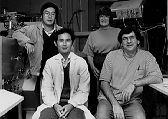
Mel Comisarow
Profile
Research and Teaching Interests
Our current research involves the development and exploitation of Fourier transform ion cyclotron resonance (FT-ICR) mass spectroscopy, fundamental research on Fourier methods in spectroscopy and application of these techniques to problems in chemistry. The advantages of FT-ICR spectroscopy, also known as Fourier transform mass spectrometry (FTMS), were first recognized and demonstrated in our lab, as was the technique itself.
The FT-ICR technique is the single most versatile method for examining the gas-phase chemical reactions of ions with organic, inorganic and organometallic compounds. Our current research of this type involves primarily the ion chemistry of organometallic specie s, which we have shown to have a particularly rich chemistry. In addition, the FT-ICR instrument has great potential as an analytical mass spectrometer, especially for involatile samples. The laser desorption ionization technique (LDI) provides a means for creating gaseous ![]() ions in one step, which can be subsequently mass analyzed by FT-ICR. LDI-FT-ICR is extremely versatile and can analyze high polymers, involatile organometallics, and a wide variety of biological molecules.
ions in one step, which can be subsequently mass analyzed by FT-ICR. LDI-FT-ICR is extremely versatile and can analyze high polymers, involatile organometallics, and a wide variety of biological molecules.
FT-ICR is best known for its ultrahigh mass resolution. Indeed, the ultrahigh mass resolution of FT-ICR spectrometers exceeds that of any other type of mass spectrometer.
FT-ICR depends heavily upon computer technology and also depends upon the mathematical algorithms that give spectroscopic parameters from the numerical computer output. We have discovered that existing techniques, while suitable for other computerized spectroscopies, lack sufficient accuracy for use in FT-ICR. We have dev eloped several approaches for analyzing FT-ICR computer output, including techniques free of the errors that are inherent in digital Fourier data.
Our development of FT-ICR spectroscopy has been warmly received by the world wide chemical community. Our FT-ICR publications have been cited over 1200 times in the scientific literature and there are now about 200 FT-ICR instruments in the world, with at least one on every continent of the earth. Most recently, the detailed citation for the 1996 Chemistry Nobel Prize, awarded for the discovery of C60, explicitly mentioned the FT-ICR "shrink-wrap" experiments that probed the hollow nature of C60.

Contact
Curriculum Vitae
B.Sc., University of Alberta (1963); Ph.D., Case Western Reserve University (G. Olah 1968); Postdoctoral, Stanford University (J. Baldescheweiler, 1969-71); Nicolet Academic Science Award (1985); Barringer Award of the Spectroscopy Society of Canada (1989); Award in Chemical Analysis and Instrumentation of the British Chemical Society (1993); Fellowship in Royal Society of Canada (1995), Field Franklin Award for Distinguished Achievement in Mass Spectrometry of the American Chemical Society (1995); Fisher Award in Analytical Chemistry of Canadian Society for Chemistry (1996).
